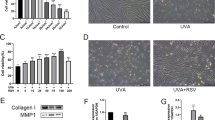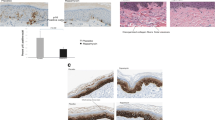Abstract
Triclosan is a broad spectrum anti-bacterial agent widely used in many personal care products, household items, medical devices, and clinical settings. Human exposure to triclosan is mainly through oral and dermal routes. In previous studies, we found that sub-chronic dermal exposure of B6C3F1 mice to triclosan induced epidermal hyperplasia and focal necrosis; however, the mechanisms for these responses remain elusive. In this study, using mouse epidermis-derived JB6 Cl 41-5a cells, we found that triclosan stimulated cell growth in a concentration- and time-dependent manner. Enhanced cell proliferation was demonstrated by a substantial increase in the percentage of BrdU-positive cells, an elevation in the protein levels of cyclin D1 and cyclin A, and a reduction in the protein level of p27Kip1. Western blotting analysis revealed that triclosan induced the activation of extracellular signal-regulated kinases 1/2 (ERK1/2), c-Jun N-terminal kinases (JNK), p38, and Akt. Pre-treatment of the cells with PD184352, an inhibitor of the upstream kinase MEK1/2, or with wortmannin, an inhibitor of phosphoinositide 3-kinase, blocked triclosan-mediated phosphorylation of ERK1/2 and Akt, respectively, and substantially suppressed triclosan-stimulated cell proliferation, whereas the JNK inhibitor SP600125 or the p38 inhibitor SB203580 had little to no effect on triclosan-stimulated cell proliferation. The phosphorylation activation of ERK1/2 and Akt was further confirmed on the skin of mice dermally administered triclosan. These data suggest that the activation of ERK1/2 and Akt is involved in triclosan-stimulated proliferation of JB6 Cl 41-5a cells.











Similar content being viewed by others
References
Alwan HA, van Zoelen EJ, van Leeuwen JE (2003) Ligand-induced lysosomal epidermal growth factor receptor (EGFR) degradation is preceded by proteasome-dependent EGFR de-ubiquitination. J Biol Chem 278(37):35781–35790. doi:10.1074/jbc.M301326200
Bagley DM, Lin YJ (2000) Clinical evidence for the lack of triclosan accumulation from daily use in dentifrices. Am J Dent 13(3):148–152
Bennett BL, Sasaki DT, Murray BW et al (2001) SP600125, an anthrapyrazolone inhibitor of Jun N-terminal kinase. Proc Natl Acad Sci U S A 98(24):13681–13686. doi:10.1073/pnas.25119429898/24/13681
Bhatt KV, Spofford LS, Aram G, McMullen M, Pumiglia K, Aplin AE (2005) Adhesion control of cyclin D1 and p27Kip1 levels is deregulated in melanoma cells through BRAF-MEK-ERK signaling. Oncogene 24(21):3459–3471. doi:10.1038/sj.onc.1208544
Brinkmann J, Stolpmann K, Trappe S et al (2013) Metabolically competent human skin models: activation and genotoxicity of benzo[a]pyrene. Toxicol Sci 131(2):351–359. doi:10.1093/toxsci/kfs316
Calafat AM, Ye X, Wong LY, Reidy JA, Needham LL (2008) Urinary concentrations of triclosan in the U.S. population: 2003–2004. Environ Health Perspect 116(3):303–307. doi:10.1289/ehp.10768
Canesi L, Ciacci C, Lorusso LC et al (2007) Effects of Triclosan on Mytilus galloprovincialis hemocyte function and digestive gland enzyme activities: possible modes of action on non target organisms. Comp Biochem Physiol C: Toxicol Pharmacol 145(3):464–472. doi:10.1016/j.cbpc.2007.02.002
Canton I, Cole DM, Kemp EH et al (2010) Development of a 3D human in vitro skin co-culture model for detecting irritants in real-time. Biotechnol Bioeng 106(5):794–803. doi:10.1002/bit.22742
Chattopadhyay A, Vecchi M, Ji Q, Mernaugh R, Carpenter G (1999) The role of individual SH2 domains in mediating association of phospholipase C-gamma1 with the activated EGF receptor. J Biol Chem 274(37):26091–26097. doi:10.1074/jbc.274.37.26091
Chibazakura T, Kamachi K, Ohara M, Tane S, Yoshikawa H, Roberts JM (2011) Cyclin A promotes S-phase entry via interaction with the replication licensing factor Mcm7. Mol Cell Biol 31(2):248–255. doi:10.1128/MCB.00630-10
Colburn NH, Bruegge WF, Bates JR et al (1978) Correlation of anchorage-independent growth with tumorigenicity of chemically transformed mouse epidermal cells. Cancer Res 38(3):624–634
Colburn NH, Former BF, Nelson KA, Yuspa SH (1979) Tumour promoter induces anchorage independence irreversibly. Nature 281(5732):589–591
Colburn NH, Wendel EJ, Abruzzo G (1981) Dissociation of mitogenesis and late-stage promotion of tumor cell phenotype by phorbol esters: mitogen-resistant variants are sensitive to promotion. Proc Natl Acad Sci U S A 78(11):6912–6916
Collins AR, Oscoz AA, Brunborg G et al (2008) The comet assay: topical issues. Mutagenesis 23(3):143–151. doi:10.1093/mutage/gem051
Dayan AD (2007) Risk assessment of triclosan [Irgasan] in human breast milk. Food Chem Toxicol 45(1):125–129. doi:10.1016/j.fct.2006.08.009
DeSalva SJ, Kong BM, Lin YJ (1989) Triclosan: a safety profile. Am J Dent 2 Spec no 185–196
Dhar A, Young MR, Colburn NH (2002) The role of AP-1, NF-kappaB and ROS/NOS in skin carcinogenesis: the JB6 model is predictive. Mol Cell Biochem 234–235(1–2):185–193
Diehl JA, Cheng M, Roussel MF, Sherr CJ (1998) Glycogen synthase kinase-3-beta regulates cyclin D1 proteolysis and subcellular localization. Genes Dev 12(22):3499–3511. doi:10.1101/gad.12.22.3499
Dong Z (2000) Effects of food factors on signal transduction pathways. BioFactors 12(1–4):17–28
Ekholm SV, Reed SI (2000) Regulation of G(1) cyclin-dependent kinases in the mammalian cell cycle. Curr Opin Cell Biol 12(6):676–684. doi:10.1016/S0955-0674(00)00151-4
Fang JL, Beland FA (2009) Long-term exposure to zidovudine delays cell cycle progression, induces apoptosis, and decreases telomerase activity in human hepatocytes. Toxicol Sci 111(1):120–130. doi:10.1093/toxsci/kfp136
Fang JL, McGarrity LJ, Beland FA (2009) Interference of cell cycle progression by zidovudine and lamivudine in NIH 3T3 cells. Mutagenesis 24(2):133–141. doi:10.1093/mutage/gen059
Fang JL, Stingley RL, Beland FA, Harrouk W, Lumpkins DL, Howard P (2010) Occurrence, efficacy, metabolism, and toxicity of triclosan. J Environ Sci Health C Environ Carcinog Ecotoxicol Rev 28(3):147–171. doi:10.1080/10590501.2010.504978
Fremin C, Meloche S (2010) From basic research to clinical development of MEK1/2 inhibitors for cancer therapy. J Hematol Oncol 3:8. doi:10.1186/1756-8722-3-8
Fresno Vara JA, Casado E, de Castro J, Cejas P, Belda-Iniesta C, Gonzalez-Baron M (2004) PI3K/Akt signalling pathway and cancer. Cancer Treat Rev 30(2):193–204. doi:10.1016/j.ctrv.2003.07.007S0305737203001622
Gotz C, Pfeiffer R, Tigges J et al (2012a) Xenobiotic metabolism capacities of human skin in comparison with a 3D epidermis model and keratinocyte-based cell culture as in vitro alternatives for chemical testing: activating enzymes (phase I). Exp Dermatol 21(5):358–363. doi:10.1111/j.1600-0625.2012.01486.x
Gotz C, Pfeiffer R, Tigges J et al (2012b) Xenobiotic metabolism capacities of human skin in comparison with a 3D-epidermis model and keratinocyte-based cell culture as in vitro alternatives for chemical testing: phase II enzymes. Exp Dermatol 21(5):364–369. doi:10.1111/j.1600-0625.2012.01478.x
Hewitt NJ, Edwards RJ, Fritsche E et al (2013) Use of human in vitro skin models for accurate and ethical risk assessment: metabolic considerations. Toxicol Sci 133(2):209–217. doi:10.1093/toxsci/kft080
Hovander L, Malmberg T, Athanasiadou M et al (2002) Identification of hydroxylated PCB metabolites and other phenolic halogenated pollutants in human blood plasma. Arch Environ Contam Toxicol 42(1):105–117. doi:10.1007/s002440010298
Huang C, Ma WY, Dong Z (1996) Requirement for phosphatidylinositol 3-kinase in epidermal growth factor-induced AP-1 transactivation and transformation in JB6 P+ cells. Mol Cell Biol 16(11):6427–6435
Huang C, Ma WY, Young MR, Colburn N, Dong Z (1998) Shortage of mitogen-activated protein kinase is responsible for resistance to AP-1 transactivation and transformation in mouse JB6 cells. Proc Natl Acad Sci USA 95(1):156–161
Huang C, Li J, Ma WY, Dong Z (1999a) JNK activation is required for JB6 cell transformation induced by tumor necrosis factor-alpha but not by 12-O-tetradecanoylphorbol-13-acetate. J Biol Chem 274(42):29672–29676. doi:10.1074/jbc.274.42.29672
Huang C, Ma WY, Li J, Goranson A, Dong Z (1999b) Requirement of Erk, but not JNK, for arsenite-induced cell transformation. J Biol Chem 274(21):14595–14601. doi:10.1074/jbc.274.21.14595
Katz M, Amit I, Yarden Y (2007) Regulation of MAPKs by growth factors and receptor tyrosine kinases. Biochim Biophys Acta 1773(8):1161–1176. doi:10.1016/j.bbamcr.2007.01.002
Keshet Y, Seger R (2010) The MAP kinase signaling cascades: a system of hundreds of components regulates a diverse array of physiological functions MAP Kinase Signaling Protocols. Springer, New York, pp 3–38
Korzeniewski C, Callewaert DM (1983) An enzyme-release assay for natural cytotoxicity. J Immunol Methods 64(3):313–320
Kumar R, Alam S, Chaudhari BP, et al. (2013) Ochratoxin A-induced cell proliferation and tumor promotion in mouse skin by activating the expression of cyclin-D1 and cyclooxygenase-2 through nuclear factor-kappa B and activator protein-1. Carcinogenesis 34(3):647–657. doi:10.1093/carcin/bgs368
Liang J, Slingerland JM (2003) Multiple roles of the PI3K/PKB (Akt) pathway in cell cycle progression. Cell Cycle 2(4):339–345. doi:10.4161/cc.2.4.433
Manning BD, Cantley LC (2007) AKT/PKB signaling: navigating downstream. Cell 129(7):1261–1274. doi:10.1016/j.cell.2007.06.009
Meloche S, Pouyssegur J (2007) The ERK1/2 mitogen-activated protein kinase pathway as a master regulator of the G1- to S-phase transition. Oncogene 26(22):3227–3239. doi:10.1038/sj.onc.1210414
Morrison DK (2012) MAP kinase pathways. Cold Spring Harb Perspect Biol 4(11) doi:10.1101/cshperspect.a011254
Netzlaff F, Lehr CM, Wertz PW, Schaefer UF (2005) The human epidermis models EpiSkin, SkinEthic and EpiDerm: an evaluation of morphology and their suitability for testing phototoxicity, irritancy, corrosivity, and substance transport. Eur J Pharm Biopharm Off J Arbeitsgemeinschaft fur Pharmazeutische Verfahrenstechnik eV 60(2):167–178. doi:10.1016/j.ejpb.2005.03.004
Nguyen TT, Scimeca JC, Filloux C, Peraldi P, Carpentier JL, Van Obberghen E (1993) Co-regulation of the mitogen-activated protein kinase, extracellular signal-regulated kinase 1, and the 90-kDa ribosomal S6 kinase in PC12 cells. Distinct effects of the neurotrophic factor, nerve growth factor, and the mitogenic factor, epidermal growth factor. J Biol Chem 268(13):9803–9810
Reus AA, Reisinger K, Downs TR et al (2013) Comet assay in reconstructed 3D human epidermal skin models–investigation of intra- and inter-laboratory reproducibility with coded chemicals. Mutagenesis 28(6):709–720. doi:10.1093/mutage/get051
Roberts PJ, Der CJ (2007) Targeting the Raf-MEK-ERK mitogen-activated protein kinase cascade for the treatment of cancer. Oncogene 26(22):3291–3310. doi:10.1038/sj.onc.1210422
Rodricks JV, Swenberg JA, Borzelleca JF, Maronpot RR, Shipp AM (2010) Triclosan: a critical review of the experimental data and development of margins of safety for consumer products. Crit Rev Toxicol 40(5):422–484. doi:10.3109/10408441003667514
Rojas M, Yao S, Lin YZ (1996) Controlling epidermal growth factor (EGF)-stimulated Ras activation in intact cells by a cell-permeable peptide mimicking phosphorylated EGF receptor. J Biol Chem 271(44):27456–27461. doi:10.1074/jbc.271.44.27456
Roskoski R Jr (2012) MEK1/2 dual-specificity protein kinases: structure and regulation. Biochem Biophys Res Commun 417(1):5–10. doi:10.1016/j.bbrc.2011.11.145
Sandborgh-Englund G, Adolfsson-Erici M, Odham G, Ekstrand J (2006) Pharmacokinetics of triclosan following oral ingestion in humans. J Toxicol Environ Health A 69(20):1861–1873. doi:10.1080/15287390600631706
Sun H, Lesche R, Li DM et al (1999) PTEN modulates cell cycle progression and cell survival by regulating phosphatidylinositol 3,4,5,-trisphosphate and Akt/protein kinase B signaling pathway. Proc Natl Acad Sci USA 96(11):6199–6204. doi:10.1073/pnas.96.11.6199
Torti VR, Wojciechowicz D, Hu W et al (2012) Epithelial tissue hyperplasia induced by the RAF inhibitor PF-04880594 is attenuated by a clinically well-tolerated dose of the MEK inhibitor PD-0325901. Mol Cancer Ther 11(10):2274–2283. doi:10.1158/1535-7163.MCT-11-0984
Trimmer GW, Hostetler KA, Phillips RD, et al (1994) 90-Day subchronic dermal toxicity study in the rat with satellite group with Irgasan DP300 (MRD-92-399). FDA Docket 1975N-0183H, OTC volume number 116
Vanlandingham MM, Fang JL, Beland FA, et al (2013) 13-week dermal toxicity of triclosan in B6C3F1 mice. The toxicologist, SOT 2013 annual meeting, p 223
Vivanco I, Sawyers CL (2002) The phosphatidylinositol 3-Kinase AKT pathway in human cancer. Nat Rev Cancer 2(7):489–501. doi:10.1038/nrc839nrc839
Walker EH, Pacold ME, Perisic O et al (2000) Structural determinants of phosphoinositide 3-kinase inhibition by wortmannin, LY294002, quercetin, myricetin, and staurosporine. Mol Cell 6(4):909–919. doi:10.1016/S1097-2765(05)00089-4
Woo RA, Poon RY (2003) Cyclin-dependent kinases and S phase control in mammalian cells. Cell Cycle 2(4):316–324. doi:10.4161/cc.2.4.468
Young PR, McLaughlin MM, Kumar S et al (1997) Pyridinyl imidazole inhibitors of p38 mitogen-activated protein kinase bind in the ATP site. J Biol Chem 272(18):12116–12121. doi:10.1074/jbc.272.18.12116
Zhang W, Liu HT (2002) MAPK signal pathways in the regulation of cell proliferation in mammalian cells. Cell Res 12(1):9–18. doi:10.1038/sj.cr.7290105
Acknowledgments
Yuanfeng Wu and Si Chen were supported by an appointment to the Postgraduate Research in the Division of Biochemical Toxicology at the National Center for Toxicological Research administered by Oak Ridge Institute for Science Education through an interagency agreement between the U.S. Department of Energy and the U.S. FDA. This research was supported through an interagency agreement between the National Center for Toxicological Research, U.S. Food and Drug Administration (FDA) and the National Toxicology Program, National Institute of Environmental Health Sciences. (FDA IAG: 224-07-0007; NIH Y1ES1027).
Conflict of interest
The authors declare that there are no conflict of interests.
Author information
Authors and Affiliations
Corresponding author
Rights and permissions
About this article
Cite this article
Wu, Y., Beland, F.A., Chen, S. et al. Extracellular signal-regulated kinases 1/2 and Akt contribute to triclosan-stimulated proliferation of JB6 Cl 41-5a cells. Arch Toxicol 89, 1297–1311 (2015). https://doi.org/10.1007/s00204-014-1308-5
Received:
Accepted:
Published:
Issue Date:
DOI: https://doi.org/10.1007/s00204-014-1308-5




